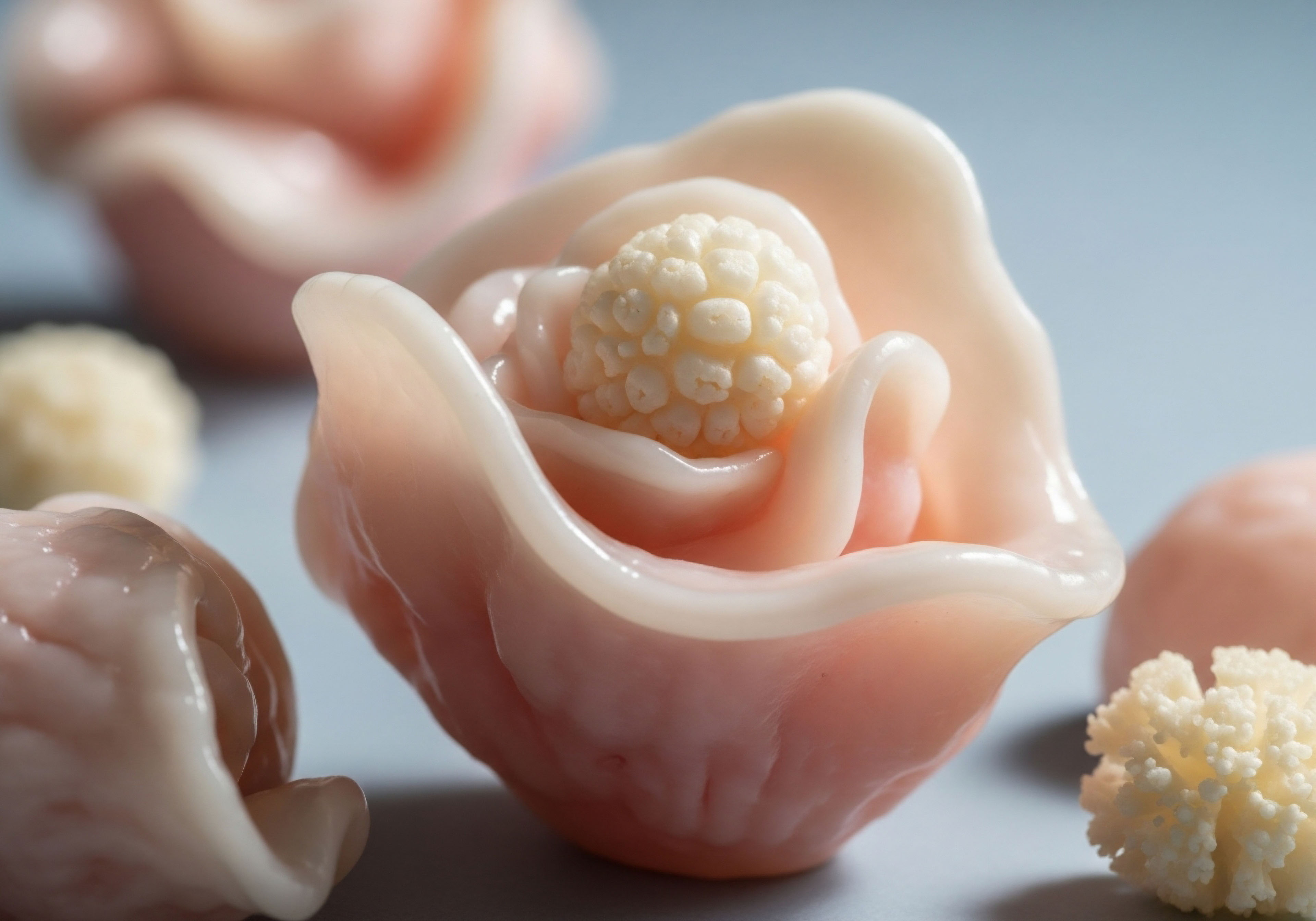

Fundamentals
When persistent discomfort lingers, or recovery from an injury feels like an unending challenge, a sense of frustration often settles in. You might experience a dull ache that simply will not subside, or perhaps a recurring stiffness that limits your daily movements.
This experience can feel isolating, as if your body is not responding as it should, leaving you searching for answers beyond conventional approaches. Understanding the intricate biological processes at play within your own system marks the initial step toward reclaiming vitality and function.
Our bodies possess an extraordinary capacity for self-repair. This innate ability orchestrates a complex sequence of events following any tissue damage. Initially, an immediate inflammatory response occurs, a vital protective mechanism that clears debris and signals for repair cells to gather.
Subsequently, a proliferative phase begins, where new cells and extracellular matrix components, such as collagen, are produced to rebuild the damaged area. The final stage, remodeling, involves the maturation and reorganization of these new tissues, restoring strength and elasticity. This entire sequence relies on precise internal communication.
Within this sophisticated biological network, the endocrine system serves as a central messaging service. Hormones, these chemical messengers, travel throughout the bloodstream, carrying instructions to various cells and organs. They influence nearly every bodily function, from metabolism and mood to growth and, critically, tissue repair.
A balanced hormonal environment provides the optimal conditions for healing processes to proceed efficiently. When these internal signals are disrupted, even subtly, the body’s capacity for repair can diminish, leading to prolonged recovery times or incomplete restoration of function.
Peptides represent a fascinating class of biomolecules, composed of short chains of amino acids. These molecules act as highly specific signaling agents within the body. Unlike larger proteins, their smaller size allows them to interact with cellular receptors in a targeted manner, initiating a cascade of biological responses.
Consider them as precise keys designed to fit particular locks on cell surfaces, unlocking specific repair pathways. Their presence can influence cellular behavior, promoting regeneration, reducing inflammation, or supporting the structural integrity of tissues.
The body’s inherent capacity for repair relies on precise internal communication, where hormones and peptides act as vital messengers.
Soft tissues, including muscles, tendons, and ligaments, are particularly susceptible to injury due to their roles in movement and structural support. Tendons, which connect muscle to bone, and ligaments, which connect bone to bone, are composed primarily of collagen fibers arranged in dense, organized structures. Muscles, conversely, consist of contractile proteins that enable movement.
Healing in these tissues presents unique challenges due to their relatively low blood supply and the specific organization required for their mechanical function. A torn tendon, for instance, requires not only new cell growth but also the precise alignment of new collagen fibers to regain its tensile strength.
The endocrine system exerts a significant influence over these healing processes. For example, growth hormone (GH) and insulin-like growth factor 1 (IGF-1) are well-known for their anabolic properties, stimulating cell proliferation and collagen synthesis. Sex hormones, such as testosterone and estrogen, also play roles in tissue maintenance and repair, affecting collagen turnover and inflammatory responses.
When these hormonal levels are suboptimal, the body’s ability to mount a robust and effective healing response can be compromised, leading to slower recovery or incomplete tissue restoration. This systemic influence underscores why a comprehensive approach to tissue healing must consider the broader hormonal landscape.
Peptide protocols offer a sophisticated means to support soft tissue healing by working in concert with these natural biological systems. They do not override the body’s inherent intelligence; rather, they provide targeted signals that can enhance specific aspects of the repair cascade.
By introducing specific peptides, we aim to amplify the body’s own restorative capabilities, addressing the underlying biological mechanisms that may be hindering optimal recovery. This approach moves beyond simply managing symptoms, focusing instead on restoring the foundational health of the tissues themselves.


Intermediate
Understanding how peptide protocols support soft tissue healing requires a closer examination of specific agents and their mechanisms. These protocols are designed to complement the body’s natural restorative processes, providing targeted biological signals that can accelerate repair and improve tissue quality. The aim is to optimize cellular function and extracellular matrix remodeling, addressing the specific needs of injured muscles, tendons, and ligaments.

Growth Hormone Peptides and Tissue Regeneration
A significant class of peptides utilized for tissue repair involves those that influence the growth hormone (GH) axis. These compounds, often referred to as growth hormone secretagogues, stimulate the pituitary gland to release more natural GH. This, in turn, leads to increased production of insulin-like growth factor 1 (IGF-1), a potent anabolic hormone. IGF-1 acts on various tissues, promoting cell proliferation, differentiation, and protein synthesis, all essential for tissue repair.
- Sermorelin ∞ This peptide is a synthetic analog of growth hormone-releasing hormone (GHRH). It binds to GHRH receptors in the anterior pituitary, stimulating a pulsatile, physiological release of GH. This approach helps maintain the natural feedback mechanisms of the GH axis, potentially reducing the risk of pituitary desensitization seen with exogenous GH administration. Sermorelin supports tissue repair by increasing overall GH and IGF-1 levels, promoting collagen synthesis and cellular regeneration.
- Ipamorelin and CJC-1295 ∞ Often used in combination, Ipamorelin is a selective GH secretagogue that stimulates GH release without significantly affecting cortisol or prolactin levels, which can be a concern with other GH-releasing peptides. CJC-1295 is a GHRH analog with a longer half-life, providing a sustained release of GH. When combined, they offer a more robust and prolonged elevation of GH and IGF-1, enhancing protein synthesis, improving connective tissue strength, and accelerating bone fracture healing.
- Tesamorelin ∞ A synthetic GHRH analog, Tesamorelin primarily reduces visceral fat in specific conditions, but its effects on GH and IGF-1 also contribute to muscle preservation and metabolic health, indirectly supporting the systemic environment for tissue repair.
- Hexarelin ∞ This peptide is another GH secretagogue, similar to Ipamorelin, but it may cause some desensitization over time. It promotes GH release and subsequent IGF-1 production, aiding in recovery and tissue repair.
- MK-677 (Ibutamoren) ∞ While technically a non-peptidic compound, MK-677 is a ghrelin mimetic that stimulates GH secretion. It offers a sustained increase in GH and IGF-1 levels, supporting muscle gain, fat loss, and improved sleep, all of which contribute to an anabolic state conducive to tissue healing.
These GH-influencing peptides contribute to soft tissue healing by:
- Stimulating Collagen Synthesis ∞ Increased GH and IGF-1 levels promote the production of collagen, the primary structural protein in tendons, ligaments, and skin. This strengthens the healing tissue.
- Enhancing Cell Proliferation and Differentiation ∞ They encourage the growth and maturation of fibroblasts, chondrocytes, and muscle satellite cells, which are crucial for rebuilding damaged tissues.
- Improving Nutrient Delivery ∞ Some peptides can promote angiogenesis, the formation of new blood vessels, which improves blood flow and nutrient supply to the injured area, accelerating repair.
- Reducing Inflammation ∞ While not their primary action, an optimized hormonal environment can help modulate the inflammatory response, preventing chronic inflammation that impedes healing.

Pentadeca Arginate and Targeted Tissue Repair
Pentadeca Arginate (PDA) represents a specific peptide with direct implications for tissue repair, healing, and inflammation. It is a synthetic peptide derived from Body Protection Compound 157 (BPC-157), a naturally occurring peptide found in human gastric juice. PDA retains the same 15 amino acid sequence as BPC-157, with an added arginate salt for enhanced stability.
The mechanisms by which PDA supports soft tissue healing are multifaceted:
- Angiogenesis Promotion ∞ PDA stimulates the formation of new blood vessels, a process vital for supplying oxygen and nutrients to damaged tissues, particularly in areas with poor vascularity like tendons and ligaments.
- Fibroblast Proliferation and Migration ∞ It encourages the growth and movement of fibroblasts, cells responsible for synthesizing collagen and other extracellular matrix components. This accelerates the rebuilding of tissue.
- Anti-Inflammatory Effects ∞ PDA exhibits properties that help reduce inflammation in injured tissues. While inflammation is necessary initially, prolonged or excessive inflammation can hinder the healing process. PDA helps to modulate this response, promoting a more conducive environment for repair.
- Collagen Synthesis Enhancement ∞ The peptide significantly increases collagen production, which is essential for restoring the structural integrity and strength of injured soft tissues.
- Growth Hormone Receptor Upregulation ∞ Some research indicates PDA can enhance the expression of growth hormone receptors in tendon fibroblasts, further linking its actions to the broader anabolic pathways.
Peptide protocols, including GH-influencing peptides and Pentadeca Arginate, provide targeted biological signals to accelerate tissue repair and improve structural integrity.
Consider the scenario of a chronic tendon injury, such as Achilles tendinopathy. Traditional treatments often involve rest, physical therapy, and anti-inflammatory medications, which may offer limited success due to the tissue’s inherent challenges in repair. Introducing a peptide like Pentadeca Arginate could potentially stimulate local angiogenesis and collagen synthesis, directly addressing the underlying tissue deficit. This approach moves beyond symptomatic relief, aiming for genuine tissue regeneration.
The application of these peptides typically involves subcutaneous injections, allowing for systemic distribution or localized effects depending on the target. The duration of protocols varies, often spanning several weeks to months, allowing sufficient time for cellular remodeling and tissue adaptation. Regular monitoring of symptoms and, where appropriate, imaging studies can help assess progress.
Here is a comparison of key peptides and their primary actions relevant to soft tissue healing:
| Peptide | Primary Mechanism of Action | Key Benefits for Soft Tissue Healing | Typical Administration |
|---|---|---|---|
| Sermorelin | Stimulates natural GH release from pituitary (GHRH analog) | Systemic anabolic effects, collagen synthesis, cellular regeneration | Subcutaneous injection |
| Ipamorelin / CJC-1295 | Selective GH secretagogue / Long-acting GHRH analog | Sustained GH/IGF-1 elevation, protein synthesis, connective tissue strength | Subcutaneous injection |
| Tesamorelin | GHRH analog, reduces visceral fat, supports muscle preservation | Indirect support for anabolic state, metabolic health | Subcutaneous injection |
| Hexarelin | GH secretagogue (may cause desensitization) | GH release, IGF-1 production, recovery support | Subcutaneous injection |
| MK-677 | Ghrelin mimetic, sustained GH/IGF-1 increase (non-peptidic) | Anabolic state, muscle gain, improved sleep, fat loss | Oral |
| Pentadeca Arginate (PDA) | Promotes angiogenesis, fibroblast activity, collagen synthesis, anti-inflammatory | Direct tissue repair, accelerated healing of tendons/ligaments, reduced inflammation | Subcutaneous injection |
The selection of a specific peptide or combination depends on the individual’s unique needs, the nature of the injury, and overall health status. A comprehensive assessment, including a review of symptoms, medical history, and relevant laboratory markers, guides the development of a personalized protocol. This tailored approach ensures that the chosen peptides align with the body’s specific requirements for optimal recovery.

How Do Peptide Protocols Support Soft Tissue Healing in Chronic Conditions?
Chronic soft tissue injuries often present a complex challenge, characterized by persistent inflammation, incomplete tissue remodeling, and a cycle of pain and dysfunction. In these scenarios, the body’s natural healing mechanisms may become dysregulated or insufficient. Peptide protocols offer a promising avenue by addressing these underlying issues. For instance, in conditions like chronic tendinopathy, there is often a failure of the tissue to progress beyond the initial inflammatory or proliferative phases, leading to disorganized collagen and weakened structures.
Peptides can help re-establish a healthy healing cascade. By promoting targeted cellular activity, such as increased fibroblast proliferation and organized collagen deposition, they can help shift the tissue from a state of chronic degeneration to one of active regeneration.
The anti-inflammatory properties of certain peptides, like Pentadeca Arginate, also play a vital role in breaking the cycle of persistent inflammation that often accompanies chronic injuries. This allows the tissue to move into the crucial remodeling phase, where strength and function are restored.
Furthermore, the systemic effects of GH-influencing peptides can improve overall tissue vitality. An optimized GH/IGF-1 axis supports not only the injured area but also the surrounding healthy tissues, enhancing their resilience and capacity for repair. This systemic support is particularly relevant in cases where multiple areas of the body are affected or where overall metabolic health contributes to delayed healing.
Chronic injuries benefit from peptides that re-establish healthy healing cascades and improve overall tissue vitality.
The application of these protocols requires careful consideration of dosage, frequency, and duration. A typical protocol might involve daily or twice-weekly subcutaneous injections for several weeks or months, depending on the severity and chronicity of the injury. Monitoring clinical progress, including pain levels, functional improvements, and objective measures like range of motion, guides adjustments to the protocol. The goal is to facilitate a complete and lasting recovery, moving beyond temporary relief to genuine tissue restoration.


Academic
A deep exploration into how peptide protocols support soft tissue healing necessitates a rigorous examination of their molecular and cellular mechanisms, alongside their interplay with the broader endocrine system. This perspective moves beyond surface-level descriptions, delving into the intricate biochemical pathways that govern tissue regeneration. The objective is to elucidate the precise ways these signaling molecules orchestrate cellular responses to injury and repair.

Molecular Orchestration of Tissue Repair
Soft tissue healing is a highly coordinated biological process involving distinct phases ∞ inflammation, proliferation, and remodeling. Each phase is characterized by the sequential activation of specific cell types and the production of various signaling molecules, including growth factors, cytokines, and extracellular matrix components. Peptides intervene in this complex orchestration by binding to specific cellular receptors, thereby initiating intracellular signaling cascades that modulate gene expression and protein synthesis.
Consider the action of growth hormone-releasing peptides (GHRPs) such as Ipamorelin or GHRH analogs like CJC-1295. These peptides bind to receptors on somatotroph cells in the anterior pituitary gland. This binding activates specific G-protein coupled receptor pathways, leading to an increase in intracellular cyclic AMP (cAMP) and calcium levels.
The elevation of these secondary messengers triggers the release of stored growth hormone (GH) and stimulates the synthesis of new GH. Circulating GH then primarily acts on the liver, stimulating the production of insulin-like growth factor 1 (IGF-1). IGF-1, in turn, binds to its cognate receptor, IGF-1R, which is a receptor tyrosine kinase. Activation of IGF-1R initiates downstream signaling pathways, notably the PI3K/Akt/mTOR pathway and the MAPK pathway.
- PI3K/Akt/mTOR Pathway ∞ This pathway is central to cell survival, growth, and protein synthesis. Its activation by IGF-1 promotes muscle protein synthesis, inhibits protein degradation, and stimulates the proliferation and differentiation of muscle satellite cells, which are crucial for muscle repair and hypertrophy.
- MAPK Pathway ∞ The Mitogen-Activated Protein Kinase pathway regulates cell proliferation, differentiation, and apoptosis. IGF-1 activation of this pathway contributes to the overall anabolic and regenerative effects observed in various tissues.
Beyond GH-axis modulation, peptides like Pentadeca Arginate (PDA) exert direct effects on tissue repair. While the precise molecular mechanisms are still under investigation, evidence suggests PDA influences several key processes. It appears to promote angiogenesis by upregulating factors such as vascular endothelial growth factor (VEGF) and its receptor, VEGFR2.
Enhanced angiogenesis ensures adequate blood supply to the injured site, delivering oxygen, nutrients, and immune cells necessary for healing. PDA also stimulates the proliferation and migration of fibroblasts, the primary cells responsible for synthesizing collagen and other extracellular matrix components. This action is thought to involve the FAK-paxillin pathway, which plays a role in cell adhesion and migration.
Peptides orchestrate tissue repair by activating specific intracellular signaling pathways, modulating gene expression, and promoting essential cellular processes like angiogenesis and fibroblast proliferation.
Furthermore, PDA exhibits anti-inflammatory properties. While initial inflammation is necessary, prolonged or excessive inflammatory responses can impede healing and lead to chronic tissue damage. PDA may modulate the release of pro-inflammatory cytokines and promote the production of anti-inflammatory mediators, helping to resolve inflammation and create a more conducive environment for tissue regeneration.
The peptide’s ability to increase collagen synthesis directly contributes to the structural integrity of the healing tissue, ensuring that the repaired area regains its mechanical strength.

Interconnectedness of Endocrine Axes in Tissue Repair
The efficacy of peptide protocols in soft tissue healing cannot be fully appreciated without considering the broader context of the endocrine system and its interconnected axes. Hormones do not operate in isolation; they form a complex network of feedback loops that collectively influence physiological processes, including tissue regeneration.
The Hypothalamic-Pituitary-Gonadal (HPG) axis, responsible for sex hormone production, and the Hypothalamic-Pituitary-Adrenal (HPA) axis, governing stress response, significantly interact with the GH/IGF-1 axis, impacting the overall anabolic and catabolic balance of the body.
Sex hormones, such as testosterone and estrogen, play direct roles in tissue maintenance and repair. Testosterone, for instance, is a potent anabolic hormone that promotes muscle protein synthesis and influences collagen turnover. Estrogen also affects collagen metabolism, bone density, and has anti-inflammatory properties.
A suboptimal hormonal milieu, characterized by low testosterone or estrogen levels, can impair the body’s capacity for tissue repair, leading to slower healing and increased susceptibility to injury. Peptide protocols that optimize the GH axis indirectly support a more anabolic systemic environment, which can synergize with balanced sex hormone levels to enhance tissue regeneration.
The HPG axis, through its regulation of gonadotropins (LH and FSH) and subsequent sex steroid production, influences the cellular environment conducive to repair. For example, adequate testosterone levels are associated with improved muscle recovery and reduced inflammation. Gonadorelin, a GHRH analog used in TRT protocols, helps maintain natural testosterone production, indirectly supporting the systemic anabolic drive essential for tissue healing. Similarly, in women, balanced estrogen and progesterone levels contribute to connective tissue health and inflammatory modulation.
The stress response, mediated by the HPA axis and glucocorticoids like cortisol, can have catabolic effects that counteract tissue repair. Chronic elevation of cortisol can suppress immune function, inhibit protein synthesis, and degrade collagen, thereby impeding healing.
While peptides do not directly target the HPA axis in the same way they do the GH axis, an overall improvement in metabolic health and reduction in systemic inflammation facilitated by peptide therapy can indirectly mitigate chronic stress responses, creating a more favorable environment for tissue regeneration.
The concept of “anabolic drive” represents the sum total of physiological processes that promote tissue growth and repair over breakdown. This drive is modulated by a delicate balance of hormones, growth factors, and nutrient availability. Peptide protocols, by selectively enhancing specific anabolic pathways (e.g. GH/IGF-1 signaling) and mitigating catabolic influences (e.g.
chronic inflammation), contribute to a sustained anabolic state. This systemic recalibration is critical for not only repairing acute injuries but also for addressing chronic degenerative conditions and supporting long-term tissue health.
Here is a summary of the molecular targets and pathways influenced by peptide protocols in soft tissue healing:
| Peptide Class / Example | Key Molecular Targets | Affected Signaling Pathways | Cellular Outcomes |
|---|---|---|---|
| GH Secretagogues (e.g. Ipamorelin, CJC-1295) | GHRH Receptors (pituitary), GH Receptors (liver, tissues) | cAMP, Ca2+ (pituitary); PI3K/Akt/mTOR, MAPK (tissues) | Increased GH/IGF-1, protein synthesis, satellite cell proliferation, muscle growth |
| Pentadeca Arginate (PDA) | VEGFR2, Fibroblast receptors, Inflammatory mediators | VEGF signaling, FAK-paxillin pathway, Cytokine modulation | Angiogenesis, fibroblast proliferation/migration, collagen synthesis, reduced inflammation |
| GHK-Cu | Collagenases, Elastases, Growth factors | ECM remodeling, Antioxidant pathways | Wound healing, collagen synthesis, anti-inflammatory, antioxidant effects |
Future directions in peptide research for tissue regeneration involve exploring novel peptide sequences, optimizing delivery methods (e.g. hydrogels, sustained-release formulations), and conducting larger-scale human clinical trials to establish long-term efficacy and safety profiles.
Understanding the precise interplay between different peptide types and their synergistic effects with existing hormonal optimization strategies will further refine personalized wellness protocols, offering more targeted and effective solutions for soft tissue repair and overall physiological resilience. The complexity of these biological systems underscores the need for a rigorous, evidence-based approach to integrating peptide therapies into clinical practice.

References
- 1. Chang, C. H. et al. “Body Protection Compound 157 (BPC-157) and its Synthetic Form, Pentadeca Arginate, Play a Major Role in Supporting Tissue Repair, Decreasing Inflammation, and Promoting Recovery from Various Conditions and Injuries.” Medical Anti-Aging, 2024.
- 2. Staresinic, M. et al. “BPC-157 (Body Protection Compound) and TB-500 (Thymosin Beta-4) ∞ Healing and Anti-Inflammatory Support.” Limitless Life Nootropics, 2025.
- 3. “Peptides for Muscle Growth and Recovery ∞ CJC-1295, Ipamorelin, & More.” Sexual Wellness Centers, 2025.
- 4. “Peptides for Muscle Growth ∞ Science, Safety, and Legal Alternatives.” BodySpec, 2025.
- 5. Easterling, M. R. et al. “Endocrine regulation of regeneration ∞ Linking global signals to local processes.” General and Comparative Endocrinology, vol. 283, 2019, 113220.

Reflection

Your Personal Path to Reclaimed Vitality
The journey toward understanding your own biological systems, particularly in the context of soft tissue healing and hormonal balance, represents a profound act of self-discovery. This exploration is not merely about acquiring information; it is about gaining agency over your physical well-being. Recognizing the intricate dance between peptides, hormones, and cellular repair mechanisms can transform your perspective on persistent discomfort or slow recovery. It shifts the focus from passive acceptance to active participation in your health trajectory.
Consider the insights shared regarding peptide protocols and their precise actions on tissue regeneration. This knowledge serves as a powerful compass, guiding you toward informed conversations with healthcare professionals. It encourages a deeper inquiry into the underlying physiological factors that influence your body’s capacity for repair. Each individual’s biological landscape is unique, shaped by genetics, lifestyle, and environmental exposures. Consequently, the path to optimal health is rarely a one-size-fits-all solution.
This understanding prompts a vital question ∞ What specific signals does your body require to optimize its inherent healing intelligence? The answer lies in a personalized approach, one that considers your unique hormonal profile, metabolic markers, and the specific nature of your tissue challenges.
Engaging with this information allows you to become a more active partner in your health decisions, advocating for protocols that align with your body’s specific needs. Reclaiming vitality and function without compromise begins with this foundational knowledge and the commitment to a tailored strategy.



